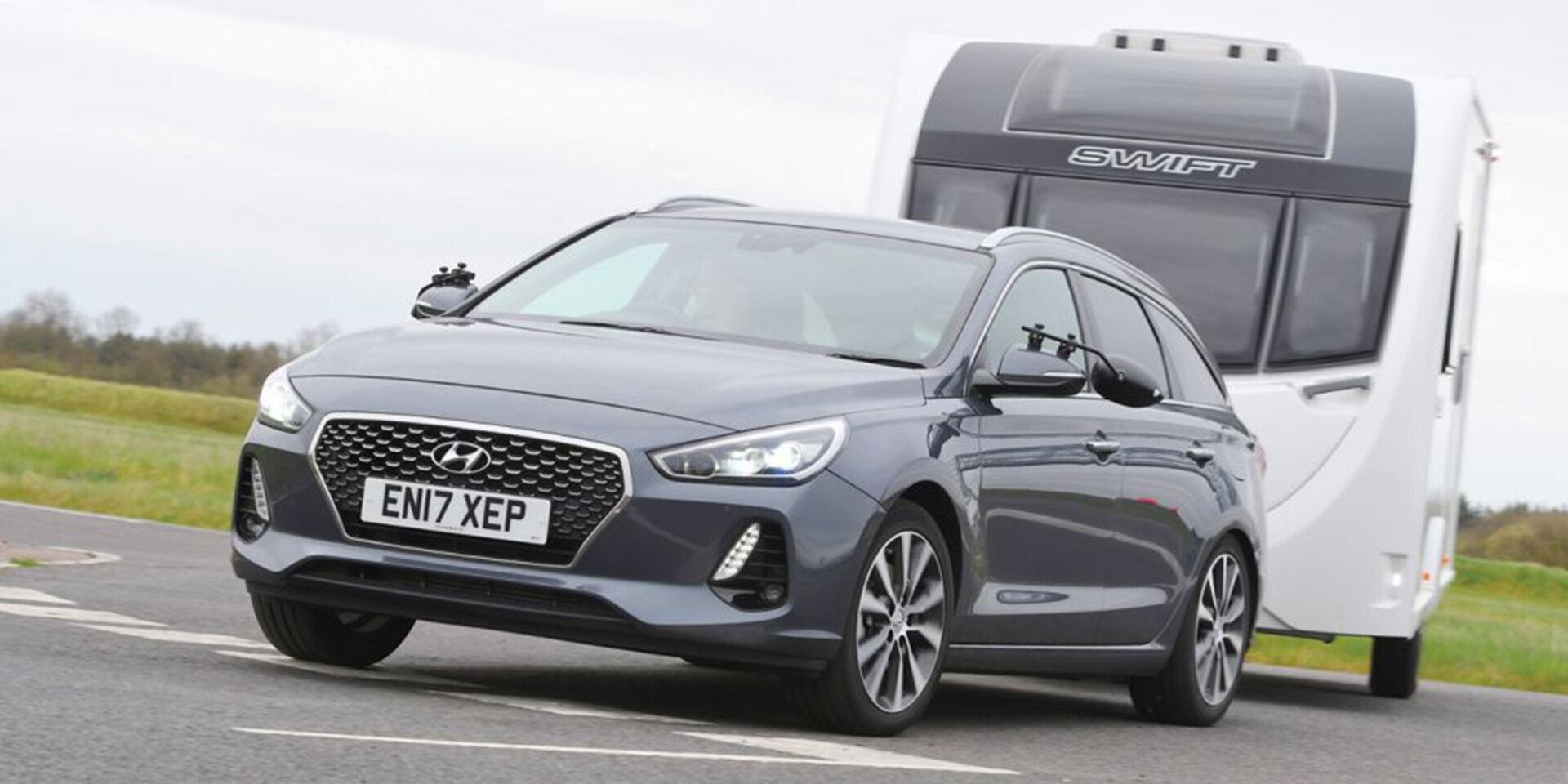Whether you’re trying camping with a caravan for the first time, need a trailer to move furniture around or want to take up boating, it can be useful to know how to tow.
If you’ve never towed before or it’s been a while, it’s a good idea to go over some basics on what to think about when towing a trailer.
Am I legally allowed to tow a trailer?
Anyone who has a full UK driving licence can tow a trailer behind their vehicle. If you only have a provisional licence, you are not allowed to tow a trailer.
However, the weight you’re qualified to tow up to varies depending on when you passed your test. If you passed before 1997, you can tow a combined vehicle and trailer weight up to 8,250kg. At this point, the rules changed. So if you passed after 1 January 1997, you are legally allowed to tow a combined weight up to 3,500kg.
The law changed in December 2021 to allow more drivers to tow without extra training. When you update your driving licence, the category ‘BE’ will automatically be filled in. Even if your current licence doesn’t show this yet, you can still legally tow provided you meet all the relevant safety requirements when towing.
Do I need to go on a towing course?
Not anymore. The law no longer requires drivers to take a car and trailer driving test, but these courses are still available. If you’re not confident about towing or you’d like a refresher, it can be helpful to get professional training to make sure you’re comfortable and safe towing on the road (or off it!).
What sort of trailer can I tow?
Anything. If your car can tow you can hook up a caravan, trailer or horse box – as long as it fits within the maximum allowable dimensions (7m long by 2.55m wide) and the weight doesn’t exceed your combined limit, you’re good to go.
A term often used to work out how much you can tow is the Maximum Allowable Mass (MAM). It’s the maximum weight the vehicle and trailer combined can be when they are both loaded, this includes passengers and luggage. It’s important this figure is not exceeded as this is the maximum the vehicle is rated to safely tow.
Can my car tow a trailer?
It’s not a given that any car is able to tow a trailer. Some vehicles are simply not rated for towing at all, and therefore can’t legally be fitted with a tow bar. Most can, however, although you won’t get a tow bar as standard equipment.
Some manufacturers offer a snazzy retractable tow bar as a factory-fitted option, while others will require an aftermarket bar to be fitted to the vehicle. Your local dealer will be happy to arrange this for you, or there are plenty of specialist centres that can fit a tow bar to your car.
When adding a tow bar to your car, it must be ‘type approved’. This means it meets thre relevant UK/EU regulations and is suitable for the vehicle.
The next task is to work out how much the vehicle is rated to tow. In the UK, trailers must be fitted with their own brakes when they weigh more than 750kg. Cars have different towing capacities for braked and unbraked trailers.
Generally speaking, smaller/lighter cars will have lower towing ratings than bigger/heavier cars. That sounds obvious, as a bigger car will cope better with the extra weight of a trailer hanging off the back. However, it’s not always that simple and there are other technical factors that determine a car’s maximum towing weight.
A vehicle’s towing capabilities are usually listed in the car’s handbook. Otherwise, this information could be found on the Vehicle Identification Number (VIN) plate, or the manufacturer’s website. You mustn’t exceed the trailer weight limit prescribed for your vehicle.
If towing figures are not shown in these locations this could be an indication the vehicle is not suitable for towing. Once again, a dealer should be able to help you get the answers you need.
What about an automatic transmission?
If you’re driving a modern car, you should have no problems towing with an automatic transmission. Most new cars these days are automatics and plenty of models are no longer available with a manual gearbox anyway, so you may not even have a choice!
With older cars, automatics used to cause problems for towing and you may have heard people say that manual gearboxes were much better. This was often due to overheating, or the transmission not being strong enough to cope with the additional load of the trailer. Some drivers also prefer the precise control available with a manual gearbox, using the gears and engine braking to help slow the vehicle rather than simply relying on the brakes.
Can you tow with an electric car?
Yes, absolutely. Electric vehicles generate loads of torque, which is what helps you move heavy loads – like a trailer weighing hundreds of kilograms. So they can make excellent towing vehicles.
The sophisticated electronics that regulate electric motors can also be used to help keep your vehicle stable and under control when towing, especially in slippery conditions. Only last week, journalists from The Car Expert got to experience towing a 1,200kg horse box with a Genesis Electrified GV70 across a challenging series of tests on wet and slippery surfaces. The car maintained its composure despite having different wheels on different surfaces, both under acceleration and during emergency stops.
With any car – regardless of power source – a big issue is significantly reduced driving range thanks to the extra weight and drag caused by the trailer. For an EV, that means longer journeys will require more frequent charging stops. Due to the design of most car parks and location of charging points, that may mean disconnecting the trailer each time you need to charge the vehicle.
For petrol or diesel cars, there’s a similarly massive impact on your car’s fuel consumption when you tow. But at least an extra fuel stop only takes a few minutes (and you can usually fill up your car with the trailer still attached), so it’s still an extra cost but less of an inconvenience.
How to hook up a trailer
Whenever you tow, the trailer behind must be fitted with a number plate that matches the vehicle that is towing. Connecting a trailer can obscure the car’s licence plate so a duplicate rear plate must be clearly visible on the back of the trailer in the correct yellow colour. You can buy these from any number of number plate retailers for about £25.
The trailer should be loaded with the weight evenly distributed so it handles predictably and doesn’t cause uneven wear on the tyres. It’s important to check the trailer is in good working order before every journey. This includes checking the rear lights, which should be connected where the tow bar is so cars behind you can tell when the brakes are applied.
Caravans tend to be wider than cars so extended wing mirrors are a legal requirement to minimise blind spots. These are fairly cheap and prevent drivers from facing points on their licence or a hefty fine. It’s also illegal to drive with extended wing mirrors when the vehicle is not towing so make sure to take them off when you detach the caravan.
How to drive when towing
Different speed limits apply when you’re towing, on single carriageways you should not exceed 50mph and on dual carriageways and motorways the maximum speed is 60mph. This should make it easier to handle the extra weight and less aerodynamic trailer or caravan.
When travelling up or down hills, it’s advisable to use a lower gear to help the car propel the extra weight up the hill or use engine braking to slow the vehicle and trailer down hill.
The wind can have more of an effect on a trailer, causing it to sway behind the car. To avoid it swinging out of control, gently slow the vehicle down and keep the car driving parallel with the road. Do not attempt to change lanes if the trailer or caravan is not completely under control.
Operating a trailer at low speeds takes a lot of awareness of your surroundings and how the trailer and vehicle interact. It can feel counterintuitive but when reversing with a trailer the vehicle needs to start reversing in the opposite direction to get the trailer to move the right way. Once the trailer has started moving the correct way, the car can then reverse as normal.
The most important tip is to plan ahead. Anticipate braking and corners nice and early, be gentle with all your inputs (steering, accelerating and braking) and keep checking all of your mirrors. Because your vehicle is now basically twice as long as normal, you need a lot more space to change lanes or navigate corners.
Looking for a tow bar, mirrors or other accessories? The Car Expert’s partners can help












